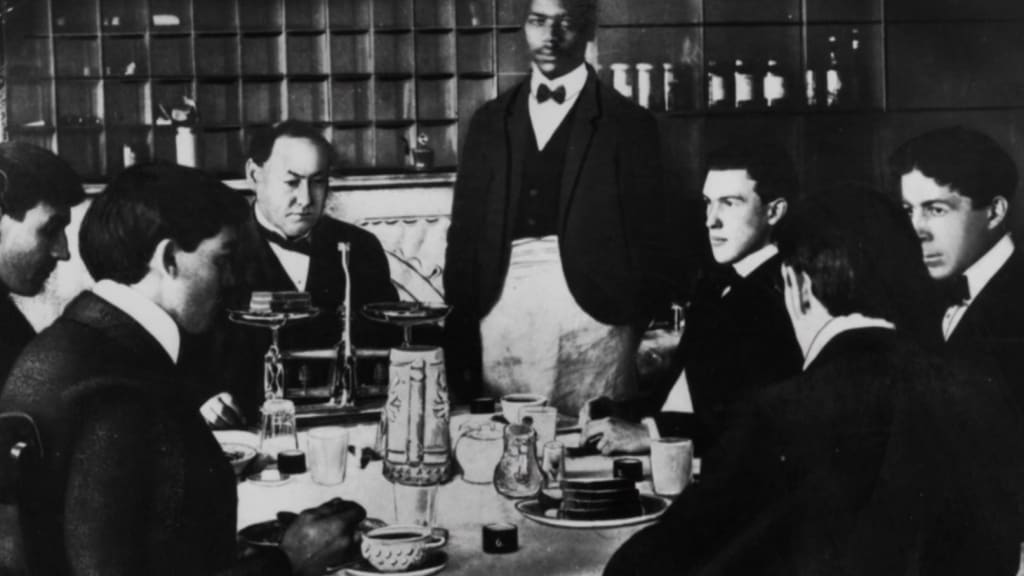Food Additives and the Rise of Serial Killers Part 1
The Correlation of Upton Sinclair, the History of the FDA, and Psychosis

In the early 1900’s, sociologist and writer Upton Sinclair was out to expose government and corporate corruption. To gather factual information for his writings, Upton went undercover, as a laborer, in a meatpacking plant, and wrote about his experiences through a fictitious book about an immigrant family who came to the United States seeking a better life. What the main character of his book discovered was that the American dream was a lie, and what his readers discovered impacted our government and the laws surrounding the sale of meat, and the way commercial foods are currently preserved. Upton Sinclair, without intending to be, is the godfather of government regulated food additives and preservatives in canned and processed foods.
In the mid 1980’s, Upton Sinclair’s book, The Jungle, was required reading in my high school, causing me to have the privilege of knowing about the gruesome and unsanitary conditions of meatpacking plants in the early 20th century. Upton described, in detail, how rats, human body parts, feces, and diseased cows with huge pus-filled boils were all acceptable as edible, at the mere cost of a small bribe to the government inspector sitting at the door.
Upton was a cruel man, the way he bluntly told the American people that they were being duped by corporate food packaging companies who were selling them contaminated meat. His story was released in small sections in a socialist magazine in 1904, that was read by many of the elite and upper middle class while they were eating their breakfast sausages. People, mostly men in high positions, were puking up their morning meals while vowing to fix the problem. They went to their government officials, and demanded that stricter laws be passed, protecting consumers from being poisoned by improperly canned and processed meats. The government, in return, put hard work into creating and passing the Meat Inspection Act to protect consumers.
Upton Sinclair published his writings in 1904, his book was published in 1906. However, food contamination in the U.S. began happening much earlier than that. The problem became an overwhelming concern within the United States Agriculture Department in the mid to late 1800’s, during the second Industrial Revolution, when processed foods saw a growth in demand.
In 1901, the US government contacted Harvey Washington Wiley, M.D., a chemist from Indiana, and offered him a position in the US Department of Agriculture as Chief Chemist. Harvey was actively investigating the chemicals that were being added to food and was concerned with how poisonous some of the additives were to the human body. After discovering his research, the government was hoping that he could solve the food contamination problem in the United States. In 1902, Harvey Wiley was promoted to the Director of the Department of Chemistry, which was quickly changed to the Division of Chemistry and then to the Bureau of Chemistry. Harvey was devoted to enforcing food additive labels on processed foods, but, after many years of researching the additives that the food industry was putting into food, he wanted the government to ban food additives altogether. The food industry protested and the 1902 Food Safety Bill, that Harvey had lobbied for, didn’t receive a single vote.
The United States government expected Harvey Wiley to research the types of chemicals that food manufacturers were adding into the foods being sold to the public. Harvey was concerned with the number of poisonous additives that were being added to food. The US government wanted to know how much a person could consume of particular poison, before becoming sick and dying. Harvey Wiley claimed to be an ethical man who wanted people, even the poorest child, to have access to healthy food. As a research scientist, hired by the government, he received permission from the United States government to use human subjects to test each food additive, as long as they were willing volunteers.
Harvey Wiley was tasked with researching a slew of poisons that the government had discovered was being added to manufactured foods. Poisons that made foods addictive, poisons that made food taste better, poisons that sanitized contaminated food, and poisons that were cheap substitutes for real and fresh ingredients were all on his list.
Harvey selected 12 healthy young men as test subjects, all students at the University of Purdue. He offered them free meals throughout each day of the study, along with a stipend of $5 a month, to keep them returning. The government provided a house for the young men to live in, and provided cooks to bake the finest foods, while adding different poisons to their diet. They were only allowed to eat the foods that the chefs prepared for them. They were participants in a controlled study.
Once this controversial study began, the news traveled across the country, and then around the world. The newspapers dubbed the volunteer human subjects “The Poison Squad”. The world was fascinated by the study, and the men who were willing to participate in it. Soon after their introduction to the public, songs were written about them.
THE POISON SQUAD
O we’re the merriest herd of hulks
That ever the world has seen;
We don’t shy off from your rough
On rats or even from Paris green:
We’re on the hunt for a toxic dope
That’s certain to kill, sans fail.
But ‘tis a tricky elusive thing and
Knows that we are on its trail;
For all the things that could kill
We’ve downed in many a gruesome wad,
And still we’re gaining a pound a day,
For we are the Pizen Squad.
On Prussia acid we break our fast;
We lunch on morphine stew;
We dine with a matchhead consomme,
Drink carbolic acid brew;
Corrosive sublimate tones us up
Like Laudanum. Ketchup rare,
While tyro-toxicon condiments
Are wholesome as mountain air.
Thus all the “deadlies” we double-dare
To put us beneath the sod;
We’re death-immunes and we’re proud as proud—
Hooray for the Pizen Squad!
By S.W. Gillilan
In the beginning of the study, the government used Harvey’s research to determine which additives were edible and which were non-edible. Poisons that made people violently sick, like formaldehyde and sulfuric acid, were put into capsules and swallowed during tested meals. The effects that they had on the volunteer subject determined whether or not the poison was considered harmful enough to be banned. Some poisons were tested more often than others, if they did not appear to make a person too sick. Borax, for example, was tested so frequently, that the good fellows of the Poison Squad threatened to go on strike. The men were sick from the poison and refused to continue testing it further. The US government was extremely hopeful that borax would have made the perfect food preservative.
Shortly after the success of the first study, the government was using the results of the research to create standards in the food industry. The worst of the poisons were banned as preservatives, and within a decade the United States had surpassed every country as a leader in food safety. Harvey Wiley and the Bureau of Chemistry was given the task of enforcing the new Pure Food and Drugs Act that the US passed in 1906. This was just the beginning of Harvey Wiley’s story and the start of the Food, Drug and Insecticide Administration, now known as the Food and Drug Administration.
The United States government gained a list of every poison that every food manufacturer in the US was attempting to use as a food preservative, or filler. Thanks to their leading chemist, it was now determined which of these chemicals could not be used as preservatives. However, the government had gotten a taste of chemistry, and now they were invested in discovering which poisonous additives could be ingested without receiving complaints from the public.
S.W. Gillilan’s song, The Poison Squad, says enough about what the subjects were forced to eat in the name of science. It should be enough to give anyone an idea of the disgusting corruption and ignorance of the people in charge of food manufacturing operations and the greed of our own government, which continues to this day.
For six years, the Poison Squad experiments continued on. In 1907, the Ladies Health Protective Association demanded that the government stop the use of human subjects to test poisons. They were successful in ending the experiments. The LHPA was the first women’s club to join the Pure Foods Movement, a grass roots movement that started up in 1884. There hope was to force food manufacturers to stop using toxic ingredients in the food that they were selling to the poor.
The Women’s Christian Temperance Union was more about protecting people from alcohol abuse, but they were disturbed by the unsanitary conditions of local slaughterhouses. They were a force to be reckoned with, and they were devoted in their work to motivate city officials to pass strong regulations concerning the operation of slaughterhouses. It wasn’t until news of the Poison Squad experiments was reported, that they decided to place food additives in the same category as alcohol. That pushed the WCTU to also join the Pure Foods Movement. From there, other women’s clubs joined the movement in an effort to protect their families and communities from the sale of toxic and contaminated food, drugs and alcohol.
The LHPA and the WCTU were the motivational force behind Upton Sinclair’s book, The Jungle. One woman involved in the WCTU, became very angry at the owner of a slaughterhouse in her city who openly disregarded all laws regarding safety and sanitation within his business. Seeking retribution, the Lady sent a full description of the unsafe and unsanitary conditions of the slaughterhouse in a letter to Upton Sinclair. It became an inspiration for his writings. This helped him to play a pivotal part in getting the Pure Food and Drug Act passed. The Pure Foods Movement was the single-most political supporter of the 1906 Pure Foods and Drug Act and the biggest reason that the Act was passed. Harvey Wiley was an active member of the Pure Foods Movement, and he utilized the Bureau of Chemistry to prove that processed food additives needed to be strongly regulated.
When I wrote, earlier, that Upton Sinclair was the godfather of food and drug regulations over food additives, I forgot to mention that Harvey Wiley was its father.
To be continued…. Read on in Part 2.
About the Creator
Chelas Montanye
I’m an advocate for education and equal health care. I love satire. I love to express myself through art and writing. Social issues fascinate and astound me. Co-founder of Art of Recycle.
Reader insights
Outstanding
Excellent work. Looking forward to reading more!
Top insights
Compelling and original writing
Creative use of language & vocab
Expert insights and opinions
Arguments were carefully researched and presented
Eye opening
Niche topic & fresh perspectives
On-point and relevant
Writing reflected the title & theme






Comments (2)
Than you for sharing.
I swear, this felt like such a tongue twister to write. I can’t imagine what it will be like for those who are reading it. It’s got some interesting facts about our food industries in the US, so it is an interesting read. I hope you enjoy!